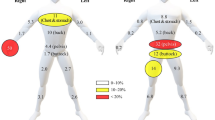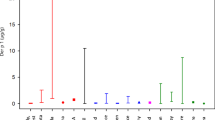Abstract
The aim of this research was to assess dermal and respiratory exposure of workers to imidacloprid during manual operations with ornamental plants previously treated in greenhouses or tunnels. A total of 10 female workers, 5 in greenhouses and 5 in tunnels, were monitored for 3 or 5 consecutive days. Actual skin contamination, excluding hands, was evaluated using nine filter paper pads placed directly on the skin. To evaluate the efficacy of protective clothing in reducing occupational exposure we also placed four pads on top of the outer clothing. Hand contamination was evaluated by washing with 95% ethanol. Respiratory exposure was evaluated by personal air sampling. Respiratory dose was calculated on the basis of a lung ventilation of 15 l/min. Absorbed doses were calculated assuming a skin penetration of 10% and a respiratory retention of 100%. Dislodgeable foliar residues (DFRs) were determined during the days of re-entry in order to determine the dermal transfer factor. From the dependence of dermal exposure of hands from DFRs, a mean transfer factor was estimated to be 36.4 cm2/h. Imidacloprid was determined by liquid chromatography with selective mass detection and electrospray interface in all matrices analysed. Respiratory dose was 4.1±4.0 (0.1–14.3)% and 3.0±2.0 (0.6–6.9)% (mean±SD (range)) of the total real dose during work in tunnels and greenhouses, respectively. The estimated absorbed doses, 0.29±0.45 μg/kg (0.06–2.25 μg/kg) body weight and 0.32±0.18 μg/kg (0.07–0.66 μg/kg) body weight (mean±SD (range)) in tunnels and in greenhouses, respectively, were less than the acceptable operator exposure level of 0.15 mg/kg body weight and than the acceptable daily intake of 0.05 mg/kg body weight. The hands and exposed skin of all workers were found to be contaminated, indicating that greater precautions, such as daily changing of gloves and clothing, are necessary to reduce skin exposure.
This is a preview of subscription content, access via your institution
Access options
Subscribe to this journal
Receive 6 print issues and online access
$259.00 per year
only $43.17 per issue
Buy this article
- Purchase on Springer Link
- Instant access to full article PDF
Prices may be subject to local taxes which are calculated during checkout






Similar content being viewed by others
References
Aprea C., Centi L., Lunghini L., Banchi B., Forti M.A., and Sciarra G. Evaluation of respiratory and cutaneous doses of chlorothalonil during re-entry in greenhouses. J Chromatogr B Biomed Sci Appl 2002: 778: 131–145.
Aprea C., Centi L., Santini S., Lunghini L., Banchi B., and Sciarra G. Exposure to omethoate during stapling of ornamental plants in intensive cultivation tunnels: influence of environmental conditions on absorption of the pesticide. Arch Environ Contam Toxicol 2005: 49 (4): 577–588.
Aprea C., Sciarra G., Lunghini L., Centi L., and Ceccarelli F. Evaluation of respiratory and cutaneous doses and urinary excretion of alkylphosphates by workers in greenhouses treated with omethoate, fenitrothion and tolclofos-methyl. Am Ind Hyg Assoc J 2001: 62: 87–95.
Aprea C., Sciarra G., Sartorelli P., Ceccarelli F., and Centi L. Multiroute exposure assessment and excretion of urinary metabolites of fenitrothion during manual operations on treated ornamental plants in greenhouses. Arch Environ Contam Toxicol 1999: 34 (4): 490–497.
Aprea C., Sciarra G., Sartorelli P., Ceccarelli F., Maiorano M., and Savelli G. Evaluation of omethoate and fenitrothion absorption in greenhouse workers using protective equipment in confined areas. Med Lav 1994: 85 (3): 242–248.
Bouchard M., Carrier G., and Brunet R.C. Assessment of absorbed doses of carbaryl and associated health risks in a group of horticultural greenhouse workers. Int Arch Occup Environ Health 2008: 81 (3): 355–370.
Brouwer D.H., Brouwer R., De Mik G., Maas C.L., and van Hemmen J.J. Pesticides in the cultivation of carnations in greenhouses: part I—exposure and concomitant health risk. Am Ind Hyg Assoc J 1992a: 53: 575–581.
Brouwer R., Brouwer D.H., Tijssen S.C., and van Hemmen J.J. Pesticides in the cultivation of carnations in greenhouses: Part II—relationship between foliar residues and exposures. Am Ind Hyg Assoc J 1992b: 53 (9): 582–587.
Brouwer R., Marquart H., de Mik G., and van Hemmen J.J. Risk assessment of dermal exposure of greenhouse workers to pesticides after re-entry. Arch Environ Contam Toxicol 1992c: 23 (3): 273–280.
Byers M.E., Kamble S.T., Witkowski J.F., and Echtenkamp G. Exposure of mixer-loader to insecticides applied to corn via a center-pivot irrigation system. Bull Environ Contam Toxicol 1992: 49: 58–65.
Calumpang S.M., and Medina M.J. Applicator exposure to imidacloprid while spraying mangoes. Bull Environ Contam Toxicol 1996: 57 (5): 697–704.
Davis J.E. Minimizing occupational exposure to pesticides: personnel monitoring. Residue Rev 1980: 75: 33–50.
Doull J., Klassen C.D., and Amdur M.O., (eds.). Cassarett and Doull's Toxicology. The Basic Science of Poisons. 4th edn. Pergamon Press, Elmsford, NY, 1991.
Du Bois D., and Du Bois E. A formula to estimate the approximate surface if height and weight be known. Clinical calorimetry, tenth paper. Arch Intern Med 1916: 17: 863–871.
Durham W.H., and Wolfe H.R. Measurement of the exposure of workers to pesticides. Bull World Health Organ 1961: 26: 75–91.
Fenske R.A., and Elkner K.P. Multi-route exposure assessment and biological monitoring of urban pesticide applicators during structural control treatments with chlorpyrifos. Toxicol Ind Health 1990: 6: 349–371.
Hellpointer E. Degradation and Translocation of Imidacloprid (NTN 33893) Under Field Conditions on a Lysimeter. Miles Report No. 106426 Miles Inc., Agricultural Division, Kansas City, MO, 1994, pp. 1–71.
INRA, Institut National de la Ricerche Agronomique. AGRITOX – Imidaclopride – Fiche d'information substance active phytopharmaceutiques 2005. http://www.dive.afssa.fr/agritox/php/fiches.php
Iwata Y., Spear R.C., Knaak J.B., and Foster R.J. Worker reentry into pesticide-treated crops. I. Procedure for the determination of dislodgable pesticide residues on foliage. Bull Environ Contam Toxicol 1977: 18: 649–655.
Kidd H., and James D.R., (eds.). The Agrochemicals Handbook. 3rd edn. Royal Society of Chemistry Information Services, Cambridge, UK, (As Updated) 1991.
Kromhout H., Fransman W., Vermeulen R., Roff M., and van Hemmen J.J. Variability of task-based dermal exposure measurements from a variety of workplaces. Ann Occup Hyg 2004: 48 (3): 187–196.
Kromhout H., and Vermeulen R. Temporal, personal and spatial variability in dermal exposure. Ann Occup Hyg 2001: 45 (4): 257–273.
Meister RT, (ed.). Farm Chemicals Handbook 1994. Meister Publishing Company, Willoughby, OH, 1994.
Muccinelli M. Prontuario dei fitofarmaci. Nona edizione. Calderini Edagricole, Bologna, 2000.
Popendorf W.J., and Leffingwell J.T. Regulating OP pesticide residues for farmworker protection. In: Residue Reviews, Residue of Pesticides and Other Contaminants in the Total Environment. Vol. 82 Springer Verlag, New York, 1982, pp 125–201.
Proenca P., Teixeira H., Castanheira F., Pinheiro J., Monsanto P.V., Marques E.P., and Vieira D.N. Two fatal intoxication cases with imidacloprid: LC/MS analysis. Forensic Sci Int 2005: 153 (1): 75–80.
Rajan-Sithamparanadarajah R., Roff M., Delgado P., Eriksson K., Fransman W., Gijsbers J.H., Hughson G., Mäkinen M., and van Hemmen J.J. Patterns of dermal exposure to hazardous substances in European union workplaces. Ann Occup Hyg 2004: 48 (3): 285–297.
Scholz K., and Spiteller M. Influence of Groundcover on the Degradation of 14C-Imidacloprid in Soil. Brighton Crop Protection Conference. Pests and Diseases 1992, Miles Inc., Imidacloprid: Pesticide leaching potential model. Report No.105008. 1993. pp. 883–888.
Spencer J.R., Bissell S.R., Sanborn J.R., Schneider F.A., Margetich S.S., and Krieger R.I. Chlorothalonil exposure of workers on mechanical tomato harvesters. Toxicol Lett 1991: 55 (1): 99–107.
Stephanou E., and Zourari M. Exposure to pesticides in greenhouses: determination of airborne residues and surface deposition. Toxicol Environ Chem 1989: 25: 17–27.
U.S. Federal Register. Imidacloprid. Pesticide Tolerances 1995: 60 (128): 24945–34943.
Uroz F.J., Arrebola F.J., Egea-Gonzalez F.J., and Martinez-Vidal J.L. Monitoring of 6-chloronicotinic acid in human urine by gas chromatography-tandem mass spectrometry as indicator of exposure to the pesticide imidacloprid. Analyst 2001: 126 (8): 1355–1358.
Wu I.W., Lin J.L., and Cheng E.T. Acute poisoning with the neonicotinoid insecticide imidacloprid in N-methyl pyrrolidone. J Toxicol Clin Toxicol 2001: 39 (6): 617–621.
Zhuang J.G., Cheng Y.J., Yang S.X., Shu J.H., and Levy L.S. The setting of an occupational exposure limit for phosphamidon in the workplace—a Chinese approach. Ann Occup Hyg 1993: 37: 89–99.
Author information
Authors and Affiliations
Corresponding author
Rights and permissions
About this article
Cite this article
Aprea, C., Lunghini, L., Banchi, B. et al. Evaluation of inhaled and cutaneous doses of imidacloprid during stapling ornamental plants in tunnels or greenhouses. J Expo Sci Environ Epidemiol 19, 555–569 (2009). https://doi.org/10.1038/jes.2008.50
Received:
Accepted:
Published:
Issue Date:
DOI: https://doi.org/10.1038/jes.2008.50
Keywords
This article is cited by
-
Skin symptoms in bakery and auto body shop workers: associations with exposure and respiratory symptoms
International Archives of Occupational and Environmental Health (2013)



